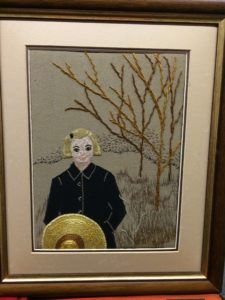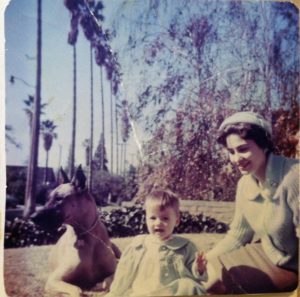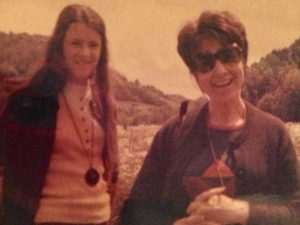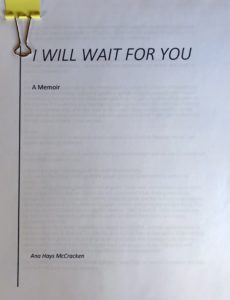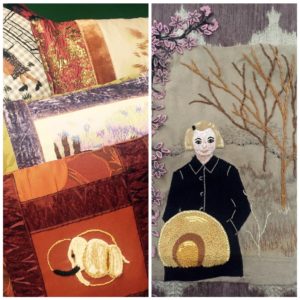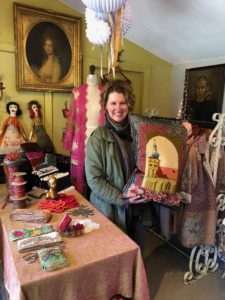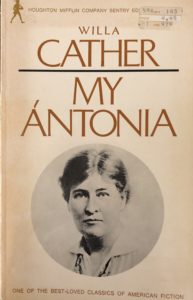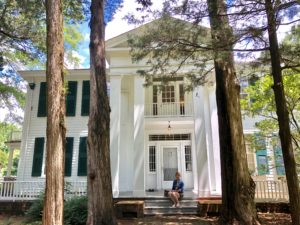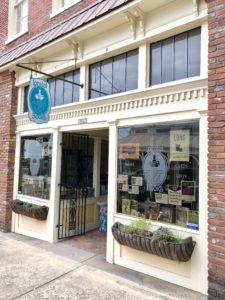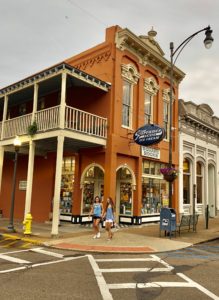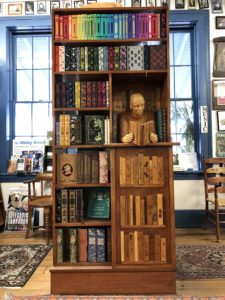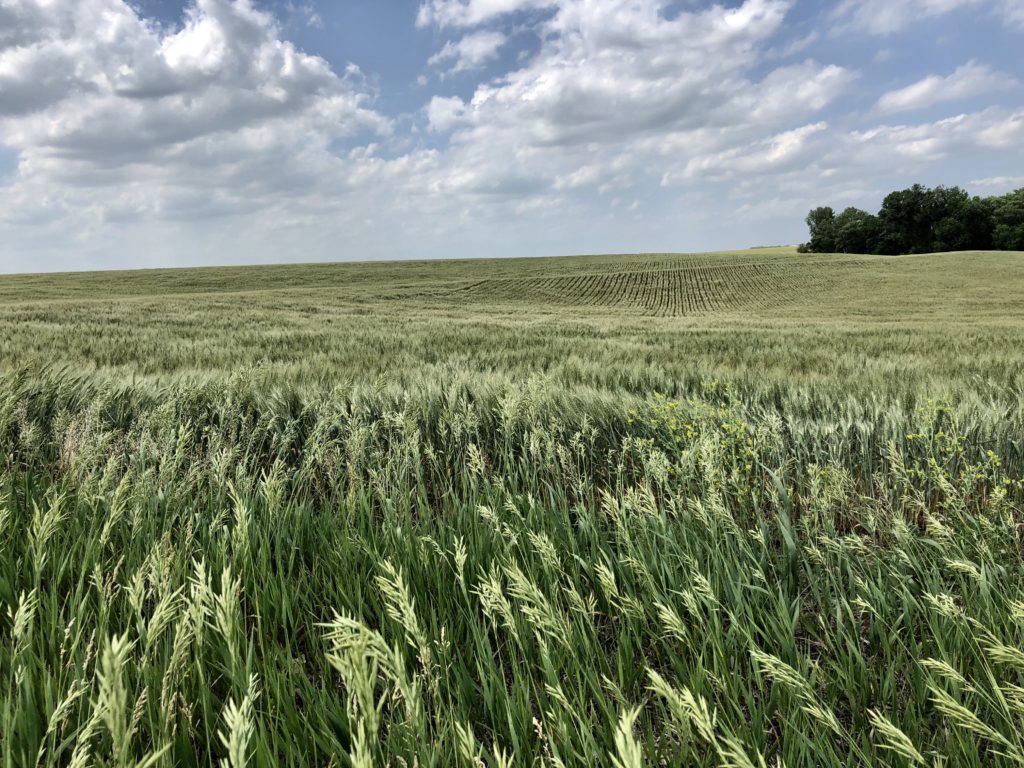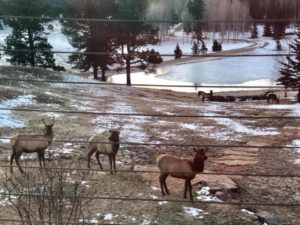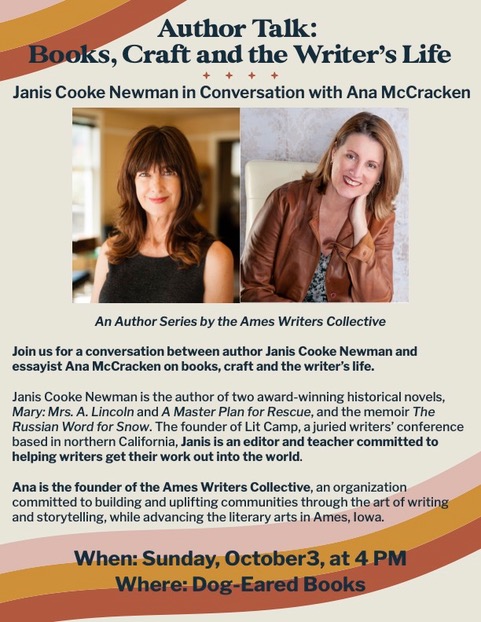Recent Blogs
Archives
- September 2021
- August 2021
- May 2021
- April 2021
- February 2021
- November 2020
- October 2020
- May 2020
- April 2020
- March 2020
- February 2020
- January 2020
- April 2019
- January 2019
- November 2018
- October 2018
- July 2018
- June 2018
- March 2018
- February 2018
- November 2017
- September 2017
- August 2017
- June 2017
- April 2017
- January 2017
- January 2016
- June 2015
- April 2015
- March 2015
- August 2014
- June 2014
- May 2014
- March 2014
- December 2013
- October 2013
- August 2013
- June 2013
The Ungenerous Reader Recommends Five Books
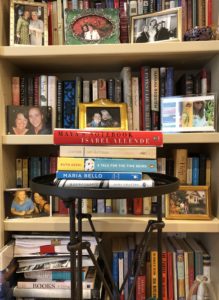 “How’s that book you’re reading,” I ask Ed, my husband.
“How’s that book you’re reading,” I ask Ed, my husband.
Ed learned how to speed read in a one-room school, and is always reading a book.
“Ok.”
“It’s good?”
“Not necessarily.”
“Then why are you reading it,” I ask.
“I don’t know? ‘Cuz I bought it.”
“You’re a generous reader,” I say.
That’s me, Ana the Ungenerous Reader.
I say that a lot in my book club, in my writing group critiquing my fellow writers. If a story doesn’t grip me by the end of page one, at the very least by the end of the first chapter, it ends up on the bookshelf in the unread section waiting for library donation, or on the nightstand by my bed collecting dust. You know that pile? Maybe you’re reading your pile? I suppose I ought to use the library more. Borrow books and bring them back if they end up by the bed. But, I can’t. Because if I’m gripped on page one, or somewhere in chapter one, invariably I reach for a pen, underline or make a note in the margin, and dog-ear the page. I cherish my dog-eared books.
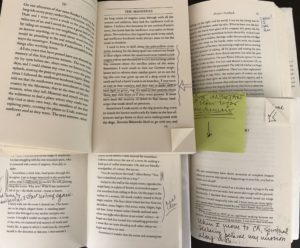 Dog-earing and making notes in margins is how I learn from other authors as a writer. I read for great dialog, descriptions and descriptor names, color name usage, you name it, I’m scouring the page. And more than that, I’m looking for myself in another author’s writing. Things I can relate to regardless of whether it’s a memoir or a novel. I think we all read for that.
Dog-earing and making notes in margins is how I learn from other authors as a writer. I read for great dialog, descriptions and descriptor names, color name usage, you name it, I’m scouring the page. And more than that, I’m looking for myself in another author’s writing. Things I can relate to regardless of whether it’s a memoir or a novel. I think we all read for that.
It’s called reading for the universal.
The books I’m recommending today touched me in a myriad of ways. Two, (My Ántonia and Hourglass—Time, Memory, Marriage) I’ve read more than two or three times. I hope you enjoy these books, and that they touch you as well. Enjoy!
Fiction
Isabel Allende—Maya’s Notebook
What fascinated me about this book was how Isabel Allende got into the head of a nineteen-year-old. But why would I think for a moment that Allende couldn’t master that?
Maya, a grieving, rebellious character goes on quite a romp to find herself. I could barely put down this book that begins in San Francisco and ends on a remote island in Chile. Maya the protagonist is headstrong, audacious, and her grandmother and I just want to shake sense into her. But Maya has to find that sense on her own. This book is also a thriller—a race from bad guys. You’ll be rooting for Maya—beginning to end.
Willa Cather—My Ántonia
For years, I have touted this book as my all-time favorite. It’s actually been years since I’ve read it, but this year I suggested it for my book club because of its centenary publication. As I began reading it again—cover to cover—it felt like a different book than I had read before. Probably because I was in high school the first time I read it. And a young adult when I read it a second time. As I read Jim Burton’s (the protagonist’s) descriptions of the Nebraska prairie, still waving in the wind when Cather wrote My Ántonia, it dawned on me why I find myself telling people that I love the Nebraska topography. Cather’s prairie descriptions must have seared themselves into my psyche. And as I continued to read on, meeting the independent women in her book who went on to have careers and not to marry, I wondered if these fictional women—women Cather must have known in real life, as she fictionalized people she knew—had somehow influenced my early life as a career woman, choosing not to marry until later in life. And lastly, I found it fascinating how the plight of and discrimination towards immigrants described by Cather hasn’t budged one iota since the time she wrote. My Ántonia, still my favorite, is a timeless book that should be taught in schools, and is meant to be read over and over again.
Ruth Ozeki–A Tale for the Time Being
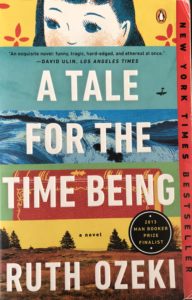 OMG! I loved this book so much, I got lost in its reality. You’ll have to read it to figure out what I mean by that. Dog-eared, notes in so many margins, no time to count them. Several years ago, I saw Ozeki interviewed at Kepler’s in Menlo Park, California, and she discussed writing this book. Fascinating. Can’t remember everything she talked about. But, the writer character in the book is loosely based upon herself. But it is fiction. And the writer-protagonist finds a lunch box washed upon the beach of the island where she lives. It’s a story about searching—for things, people, and self. I could barely put this book down to live my own life. This book still haunts me, in a good way. I look forward to reading it again.
OMG! I loved this book so much, I got lost in its reality. You’ll have to read it to figure out what I mean by that. Dog-eared, notes in so many margins, no time to count them. Several years ago, I saw Ozeki interviewed at Kepler’s in Menlo Park, California, and she discussed writing this book. Fascinating. Can’t remember everything she talked about. But, the writer character in the book is loosely based upon herself. But it is fiction. And the writer-protagonist finds a lunch box washed upon the beach of the island where she lives. It’s a story about searching—for things, people, and self. I could barely put this book down to live my own life. This book still haunts me, in a good way. I look forward to reading it again.
Memoir
Maria Bello—Love is Love, Questioning the Labels We Give Ourselves
 I stumbled upon this book because one of the chapters was published in the NYT Modern Love column. Perhaps you read it, or know Maria Bello as an actress? That’s how I first knew her. She now plays a psychologist on NCIS and I love her character as much as I love her book.
I stumbled upon this book because one of the chapters was published in the NYT Modern Love column. Perhaps you read it, or know Maria Bello as an actress? That’s how I first knew her. She now plays a psychologist on NCIS and I love her character as much as I love her book.
Infected by a parasite she contracted in Haiti, Maria falls ill, and while recuperating she reads through old journals that cause her to question herself. Those questions became this book. I suppose I began reading it because of the structure of the book. Each chapter, a question, is basically a stand-alone essay. But together the chapters braid a book of her life that I found fascinating. Many of Bello’s questions caused me to question myself. Of course, you can just read the book and enjoy it. Love is Love is funny, evocative, and a thoughtful read.
Dani Shapiro—Hourglass, Time, Memory, Marriage
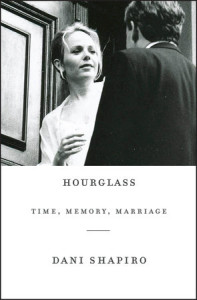 If you know me, you know I love and have studied with author Dani Shapiro. I’m waiting with bated breath for her next memoir. Last summer, I woke one morning remembering she was in Minneapolis that night giving a reading for her recently-published memoir, Hourglass, at Mager & Quinn bookstore. A three-hour drive from Ames, I pondered for a minute. Two hundred and sixteen miles isn’t too far for me to drive to see Shapiro. I’ve read Hourglass two times now. What I love about this book is how Dani structured it. It’s a mosaic of stories about memory, love, life, and motherhood. If you are reading for a definitive thread, then maybe you won’t like it. But for me, my mind works that way, and so does yours if you think about it. Hourglass is a gem—a wonderfully insightful and tender read that reaches into the depths of what it is to be human.
If you know me, you know I love and have studied with author Dani Shapiro. I’m waiting with bated breath for her next memoir. Last summer, I woke one morning remembering she was in Minneapolis that night giving a reading for her recently-published memoir, Hourglass, at Mager & Quinn bookstore. A three-hour drive from Ames, I pondered for a minute. Two hundred and sixteen miles isn’t too far for me to drive to see Shapiro. I’ve read Hourglass two times now. What I love about this book is how Dani structured it. It’s a mosaic of stories about memory, love, life, and motherhood. If you are reading for a definitive thread, then maybe you won’t like it. But for me, my mind works that way, and so does yours if you think about it. Hourglass is a gem—a wonderfully insightful and tender read that reaches into the depths of what it is to be human.
Posted in Blogs, Uncategorized
Leave a comment
Postcard from the South | Number 4
A WRITERS’ TOUR OF THE SOUTH
Trip Highlights #2
A lot of Ed’s and my trip after we deposited the grandkid at Huntsville Space Camp was unplanned. Our one known destination was the battlefields at Vicksburg. As we lounged in our hotel room in Birmingham last week, plotting our route, I Googled “authors of Mississippi”. There are many. But two, Eudora Welty and William Faulkner were in the regions we intended to drive.
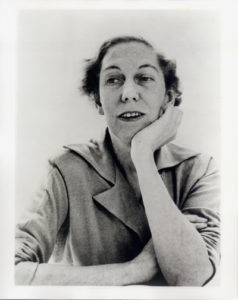 EUDORA WELTY
EUDORA WELTY
(b 1909 -d 2001)
Born and died in Jackson, Mississippi
Sadly the Eudora Welty House and Garden Museum was closed on Monday when we drove through Jackson, Mississippi. But we stopped anyway, and I posed on the front steps of Welty’s house.
Eudora Welty’s name, to me, seems to pop up everywhere. Yet, I’m sure I’ve not read her stories and books? A short story writer and novelist, Welty won the Pulitzer Prize for Fiction for her novel, The Optimist’s Daughter (1972).
Born in Jackson, Welty studied at Mississippi State University for Women, then transferred to the University of Wisconsin to further study English. Following graduation, she studied at Columbia where her father suggested she study advertising. Graduating in the depths of the Great Depression, no jobs in advertising were to be had in NYC. Welty returned to Jackson. (More can be found on Wikipedia.)
It was disappointing the Welty Museum was closed. Perhaps reading her memoir, One Writer’s Beginnings (1983), I might learn more about the influences in her life. I am fascinated by parents, fathers in particular, of that era (thinking of Willa Cather) who encouraged female higher education. I remark to Ed frequently that there are windows of time where women were schooled and encouraged to study subjects other than nursing and teaching. (A common complaint of mothers of my generation.) I’ve gotta list growing of these intriguing women.
WILLIAM FAULKNER
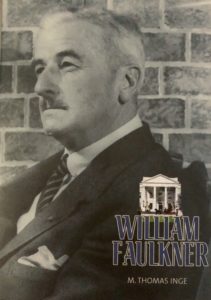 (b 1897 – d 1962)
(b 1897 – d 1962)
Born in New Albany, Mississippi
Died in Oxford, Mississippi
Well, I hate to admit it. Faulkner would be abhorred. I’m pretty sure I’ve confused him for years with William Styron, who wrote Sophie’s Choice. Um… Both Williams. But I’m pretty sure I read The Sound and the Fury in high School. What a nincompoop I am. Especially when William Faulkner is internationally acclaimed as one of the greatest writers in the twentieth century.
Why admit it? ‘Cuz that’s what I do. And I’m glad to have been able to re-educate myself on our road-tour of the south.
From what I’m reading in my thin and compact William Faulkner biography by M. Thomas Inge, Faulkner was a bit of a pill, undaunted, and sly.
Undaunted and Sly: When Faulkner was rejected from the aviation branch of the United States Army Signal Corps, he put the “u” back in his name, affected a British accent, created a fictional persona of British clergyman for himself, and enlisted in Canada. He wanted to experience WWI combat like Hemingway, Fitzgerald, and E. E. Cummings. During training, Faulkner is purported to have crashed two planes. War ended, he didn’t see combat. He returned home to Jackson and strutted around town with his swagger stick, resplendent in his officers uniform, earning himself the nickname of “Count.”
A Pill: I’m kinda gathering he had a haughty attitude as a slight and short-statured man. He left Old Miss (University of Mississippi) after a semester because he was disinterested. Went to NYC to work at Lord & Taylor Bookstore while he sought publication (He had a friend mentoring and promoting him), returned to Oxford and took employ at the Old Miss post office. He resigned after three years, but not before being scolded for neglecting to timely stamp and send mail, and the delay of sending magazine subscribers their magazines until he had read them.
Faulkner’s novels were made into movies, and he was prolific. And, in 1950 Faulkner won the Nobel Peace Prize for Literature.
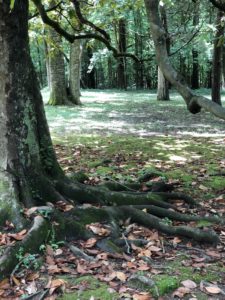 Visiting his home at Rowan Oak was a treat. Not only to see where he wrote, but how modestly he and his family lived, and to experience the serenity of his property. In Faulkner’s writing study in the back of his house (an addition which he built), Ed and I marveled at the timeline/plot points he penciled upon his walls. He learned to do this in Hollywood during the writing and making of his novels into movies.
Visiting his home at Rowan Oak was a treat. Not only to see where he wrote, but how modestly he and his family lived, and to experience the serenity of his property. In Faulkner’s writing study in the back of his house (an addition which he built), Ed and I marveled at the timeline/plot points he penciled upon his walls. He learned to do this in Hollywood during the writing and making of his novels into movies.
 One last comment. Something I’ve noticed about authors such as Cather, Welty, Faulkner. They all had mentors. Some (as in the collective some) were their life-long editors, others publishers, other their champions. When I get my book(s) published, I pass this tradition forward.
One last comment. Something I’ve noticed about authors such as Cather, Welty, Faulkner. They all had mentors. Some (as in the collective some) were their life-long editors, others publishers, other their champions. When I get my book(s) published, I pass this tradition forward.
Photo credits: photograph of Eudora Welty, first Published April 21, 1962; photograph of William Faulkner, © Library of Congress.
Posted in Blogs, Uncategorized
Tagged 1950 Nobel Prize for Literature, Eudora Welty, Eudora Welty Garden House, Jackson Mississippi, New Albany Mississippi, Old Miss, Oxford Mississippi, Pulitzer Prize for Fiction 1972 The Optimist's Daughter, Rowan Oaks, University of Mississippi, Willa Cather, William Faulkner
1 Comment
Postcard from the South | Number 3
A WRITERS’ TOUR OF THE SOUTH
Trip Highlights #1
BOOKSTORES & COFFEE
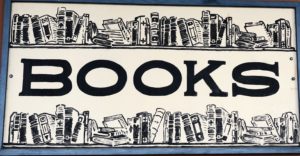 As I sit waiting to fly back to Des Moines, my thoughts return to a couple of trip highlights—authors, bookstores, and coffee. This brief post features coffee and bookstores. (Check out Postcard from the South | Number 4 for Author Highlights.)
As I sit waiting to fly back to Des Moines, my thoughts return to a couple of trip highlights—authors, bookstores, and coffee. This brief post features coffee and bookstores. (Check out Postcard from the South | Number 4 for Author Highlights.)
Vicksburg, Mississippi
If you visit Vicksburg, Mississippi be sure to visit Highway 61 Coffee located next to Lorelei Books. Both are outstanding. At Highway 61 Coffee, cappuccinos don’t require an extra shot. “Ausgezeichnet” for a Starbucks quad-shot Vente cappuccino kinda gal.
And, Lorelei Books. Wow! What a delight. According to the manager, Haley Sellers, who let me pick her brain about how to own, operate, and make a success of an indie bookstore, the owner and she tailor selections for travelers. Their local readership knows books not on bookshelves can be ordered. Some of the genres Lorelei Books carries for travelers are local and regional history, and new memoir. For locals, Lorelei Books hosts author events and Storytime for kids on Saturdays. I love their bookstore tagline on their website:
“Luring Booklovers to Lore. Books of paper and ink sold in a brick-and-mortar bookstore by human beings. Come enjoy real life with us.”
Oxford, Mississippi
In Oxford, Mississippi, I’d mention Uptown Coffee just off the square, but their cappuccino scalded my tongue and throat badly, and the guy sporting a cap and convict-worthy-body tats told me when I asked for another, “just let it cool off.” He was obviously too young to remember the McDonald’s lawsuit.
Whereas the bookstore on the square, Square Books, is über-worthy of mention. Man, what a selection of Mississippi writers they have. Picked up a slim and compact biography on Faulkner written by M. Thomas Inge.
It’s an awesome thing when you stumble upon communities supporting bookstores with coffee and espresso shops worthy of mention.
Snapshot of book logo up top, snapped from the side of Square Books in Oxford, Mississippi
Along the Loess Hills Scenic Byway
Leaving Omaha today, I chose to take the scenic route home to Ames. So, I headed north up I-29 to Mondamin, and turned off to hook up with Hwy 183 to 141, which took me on the Loess Hills National Scenic Byway. Then on to Dennison where I met up with Hwy 30, the Lincoln Highway. The intent: to see prairie and rolling hills, and to drive through Jefferson where I’ll join RAGBRAI for the first of my a two-day ride at the end of July.
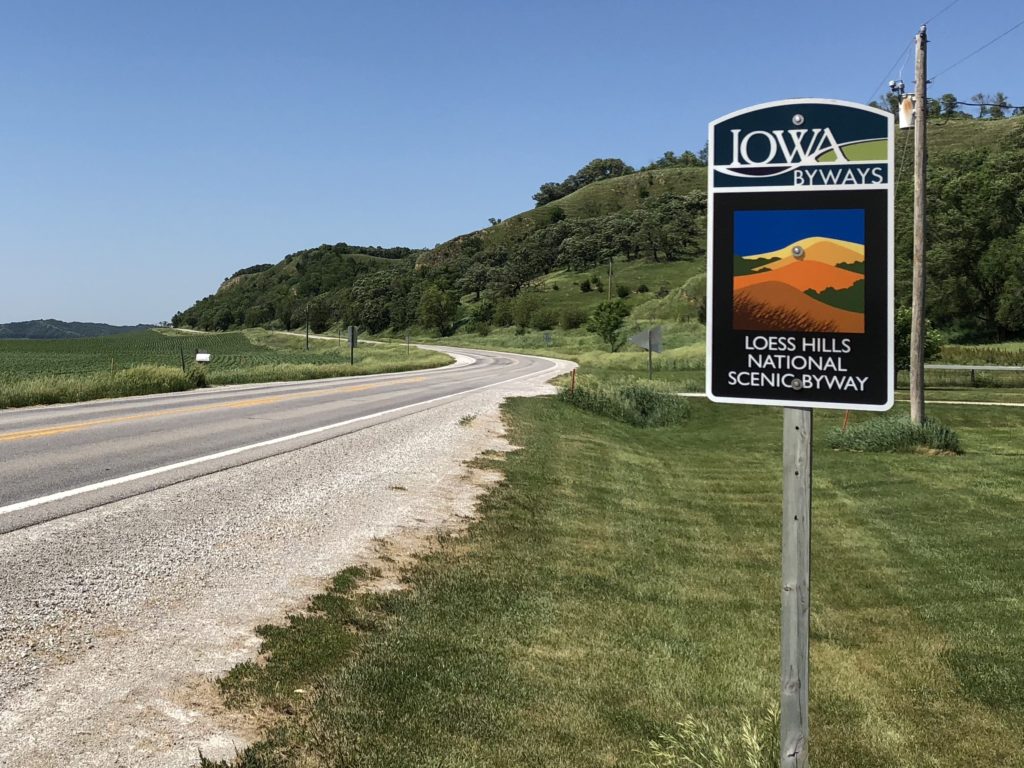 Not versed in geological history of the region, I can say before heading into the Loess Hills, I saw Iowa farm land as flat as a pancake. I image if I’d had a level, the bubble-blob would have rested smack dab in the middle. And in the hills over looking that same flat valley, a path trailed off atop looking akin to the range along Skyline Drive above Palo Alto, California where I used to live.
Not versed in geological history of the region, I can say before heading into the Loess Hills, I saw Iowa farm land as flat as a pancake. I image if I’d had a level, the bubble-blob would have rested smack dab in the middle. And in the hills over looking that same flat valley, a path trailed off atop looking akin to the range along Skyline Drive above Palo Alto, California where I used to live.
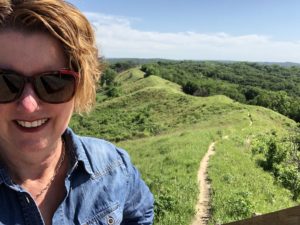 And heading into Dennison, and eastward towards home, I noticed what appears to me farmland rimmed in prairie grasses. I’d heard rumors farmers were doing this, as the root systems of prairie grass cleanses nitrogen runoff. Wizzing by switchgrass and other grasses whose names are not known to me yet, hope gurgled up inside me.
And heading into Dennison, and eastward towards home, I noticed what appears to me farmland rimmed in prairie grasses. I’d heard rumors farmers were doing this, as the root systems of prairie grass cleanses nitrogen runoff. Wizzing by switchgrass and other grasses whose names are not known to me yet, hope gurgled up inside me.
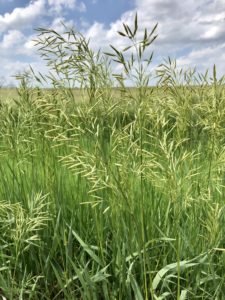 Of course I had to eat. On recommendation I dined on the five-dollar Monday special at Cronks in Dennison (three fried chicken legs, fries, coleslaw, biscuit and a cookie (I didn’t eat the biscuit nor cookie hoping for ice cream down the road.), and delighted in a peanut butter fudge waffle cone at an ice cream spot off the cute historic square in Jefferson.
Of course I had to eat. On recommendation I dined on the five-dollar Monday special at Cronks in Dennison (three fried chicken legs, fries, coleslaw, biscuit and a cookie (I didn’t eat the biscuit nor cookie hoping for ice cream down the road.), and delighted in a peanut butter fudge waffle cone at an ice cream spot off the cute historic square in Jefferson.
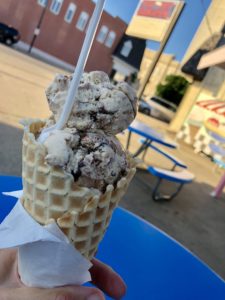 What struck me most today was the expanse of land, a sea of waving green.
What struck me most today was the expanse of land, a sea of waving green.
Posted in Blogs, Uncategorized
Tagged Cronks, Dennison Iowa, Jefferson Iowa, Loess Hills, Loess Hills National Scenic Byway, RAGBRAI 2018, Switchgrass
2 Comments
The Country Seemed to be Running
 Today, my long-time chum, Mary and I took a a break from the annual Willa Cather conference in Red Cloud, NE celebrating the centenary publication of My Antonia, and headed due south on US-281. A pilgrimage of sorts to stand on the Geographical Center of the 48 contiguous states, a mile north of Lebanon, KS.
Today, my long-time chum, Mary and I took a a break from the annual Willa Cather conference in Red Cloud, NE celebrating the centenary publication of My Antonia, and headed due south on US-281. A pilgrimage of sorts to stand on the Geographical Center of the 48 contiguous states, a mile north of Lebanon, KS.
With pilgrimages, one might hope for an epiphany, perhaps. I hoped for nothing driving 19.1 miles with Mary to stand at the contiguous center. What I did encounter from our quick journey was wind, fields of waving wheat trimmed at roads’ edge with switchgrass.
Willa Cather in My Antonia writes of wine-red prairie grass waving in wind, pioneer women went stark raving mad from the wind, I am fascinated by and love wind.
As I stood in the dry 95-degree heat, mesmerized by the rolling waves of green, I didn’t care about the contiguous center, I cared about wading in Cather’s words:
“As I looked about me I felt that the grass was the country, as the water is the sea. The red of the grass made all the great prairie the colour of wine-stains, or of certain seaweeds when they first washed up. And there was so much motion in it; the whole country seemed, somehow, to be running.” ~Jim Burton, My Antonia
And yes, gazing out upon the waving wheat, the country did indeed appear to be running.
New Mexico Nature Photo Essay
Any early morning trip, leaving New Mexico for Iowa. The elk are up and busy being majestic, while the sky over Taos threatened retribution from forgotten gods of old. Take care, intrepid traveler.
Posted in Blogs, Uncategorized
Leave a comment
Skunk River Photo Essay
Today, Avy and I walked three miles along the Skunk River Water Trail, which I learned stretches for thirty-two miles from Story City to south of Huxley. (Map, next-to-last pic.)
Avy and I set off from a parking lot down the road from the historic site of Soper’s Mill.
The terrain similar to my walk last week, I wondered what I’d photograph.
And then, we discovered a dilapidated bridge stretching over the Skunk. And of course, there were a few other photo ops along the way. (more…)
Posted in Blogs, Uncategorized
3 Comments
Lone Hiker, Blessed Day Photo Essay
On our walk today, Avy and I encountered a lone hiker in the forest.
“Hello. How are you?” I asked
“Oh what a blessing to have this day,” she said, passing.
What else is there to say?
Posted in Blogs, Uncategorized
Leave a comment
Ames Woods Photo Essay
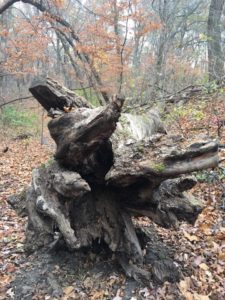 Today Miss Avy and I went on a hike in a wooded area in Ames. I’m loathe to say where as we encountered only a mom and her son, who delighted in petting Avy’s nose.
Today Miss Avy and I went on a hike in a wooded area in Ames. I’m loathe to say where as we encountered only a mom and her son, who delighted in petting Avy’s nose.
Avy’s good with little kids.
The only noises we heard were the occasional bird chirps and chipmunks clicking. What a marvel the woods were. Leaves mostly fallen, moist, ready to wither and mingle with the rich dark soil.
Ahhh. Did me good to walk behind Miss Avy as she sniffed her way ahead of me.
Posted in Blogs, Uncategorized
2 Comments


